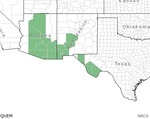Quercus emoryi

Oak Varieties

QUEM Range
Common Names: Live Oak
Habitat: Hillsides and drainages with a typical elevation range of 3,000-8,000 feet.
Description: dark green, oblong,shiny leaves with spines at the margins (leaf edges). The bark is black on mature trees. It can exist as a shrub or a tree, but can reach a height of 40 feet or more and trees often have very upright growth habit. It is drought-deciduous (loses it leaves during the May-June dry season) Source: AZ Cooperative Extension, Yavapai County
Comments: Also see "Canyon Live Oak". Both species can exist within the same habitat.
Also called black oak, blackjack oak, bellota.
Description Medium-sized evergreen tree to 50 feet in height and 2 1/2 feet in trunk diameter. Leaves broadly lance-shaped, 1 to 2 1/2 inches long, with a short spiny point and a few short spiny teeth, thick, stiff, leathery, flat, shiny yellowish green on both sides, nearly hairless, shedding gradually in spring as the new leaves unfold. Acorn 1/2 to 3/4 inch long, rounded, one-third or more enclosed by the cup, sweetish and edible. Bark thick, divided into thick plates, black. Wood hard and heavy, dark brown with thick lighter sapwood.
Distribution The most abundant and most characteristic tree of the oak woodland in the Mexican border region, in foothills, mountains, and canyons and sometimes also in canyons at upper edge of desert and desert grassland, 4,000 to 7,000 feet (rarely 8,000 feet) elevation. New Mexico: mountains of southwestern corner, from Black Range southwestward. Arizona : mountains of southeastern and central parts, west to Santa Cruz and Pima Counties and northwest below Mogollon Rim to Gila County, southern Coconino County (Oak Creek Canyon), and Yavapai County. Also in southwestern Texas and northern Mexico.
Emory oak is named from Lt. Col. W. H. Emory (1811-87), leader of a military expedition in the Southwest in 1846-47, during the Mexican War, who first collected specimens of this species at Pigeon Creek (Las Palomas), within the present Sierra County, N. Mex. In moist places, especially in canyons, Emory oak forms fairly dense forests. It is one of the most important sources of firewood in southern Arizona. The acorns, known in Spanish as bellotas, are nearly free from tannin with its bitter taste and are gathered and eaten locally by Indians and Mexicans


















